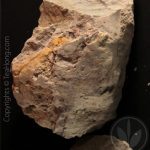- Clay ore of duan-ni
- A Yixing teapot of the Little Celeste style made from duan-ni
Yixing teapot to tea-making is rather like the oak barrel is to wine making, perhaps with a bit more significant influence to the final quality of the “brew”. Once you master its usage and the relationship with each variety of tea, the taste effect obtainable can be beyond comparison by that from any other equipment. Finer Yixing pots are also often of collection and investment values. That is why it is a most treasured and unique category of teaware in the Far East.
- Zisha proper, the raw clay that refines to the purple clay of Yixing. The yellow patches are other minerals, including sulphur compounds, that need to be removed during refinery
- A Panhu style Yixing teapot made from zisha
The Clay
Yixing is the name of a county (now administratively a city) in Jiangsu province at the Yangtze River delta in the eastern part of China. Since the Ming Dynasty, the clay mined from the Huanglong (Yellow Dragon) Mountains here has been prized for making unique quality teapots that can best optimize tea quality.
A dark color clay which after proper firing shows a purplish sheen on the surface was most popular in the beginning. Yixing clay thus came to be known as zisha (purple sand), although there have been in practice the use of different color clays from the same mines.
Shrinking Supply
Today, mines have been set up in a few mountains in the area to satisfy the ever growing demand, but shrinking supply. Artists, scholars and scientists have been arguing about whether clay from this area really is not found elsewhere. The fact is, nowhere else seems to have produced any natural clay so dense and beautiful. Nevertheless, pots made in genuine Yixing clays have a special position in preparing that truly special cup of tea for die-hard tea aficionados. Artists who have used this clay to make pots seldom find a more responsive material. Japan and Taiwan are two countries that have been buying clay from here for making exclusive quality teapots.
- Shi-huang (stone yellow), the ore that refines to zhu-ni. This egg shape stone will have to be broken for the yellowish core inside. It refines to the clay that turns orange red on firing
- A Duo Qui style Yixing teapot made from zhu-ni
Some people also see great investment opportunity in an ever shrinking supply vs ever increasing demand situation. They are buying pots from artists, auction houses and reliable merchants. Some others are even stocking the raw materials.
Art, Ores and Techniques
There are in popular use over 15 kinds of clay ores each with different mineral contents and thereby colors and physical properties. Some, such as zisha, hong-pi-long, zhu-ni, etc can be used on their own. All can be inter-mixed.
It is important to know that there is a whole class of technicians whose job is to process and blend clay to various quality criteria. Artists work with them for clay qualities that best suit certain personal traits and/or project requirements.
Various firing approaches give the same clay a different color and sometimes a different surface. Some artists fire their own pots, but more work with kiln owners to do the job for them.
Unique surface, color and material quality of a teapot is therefore a result of how well the pot artist works with the other technicians to best actualize his/her styling.
- Hong-pi-long, the ore gives high quartz content and a dark-reddish color to the pot
- A Fanggu style Yixng teapot made from “hong pi long” clay ore
A Gentle Reminder
Another important thing to know is that there are more products made from fake Yixing clays out there than genuine ones. A lot of them are common clay mixed with questionable chemicals. Contrary to popular beliefs, price is not a reflection of whether it is the genuine clay.
Neither is the easily forged “certificates” or seals by the artist. Nor whether the surface is shiny or dull. Knowledge, sensitivity and experience are the only way to decipher the worthiness of an item. Before you are properly equipped with these qualities through enough reading, physical contacts, adventures and heart-breaking mistakes, please consider buying from an honest merchant who really knows, like us.
- More…
- Handcrafting Yixing Teapots
- Ergonomic Criteria for a Yixing Teapot
- Standard Traditional Forms
- Artist Ranking
Related Tea Guardian article















